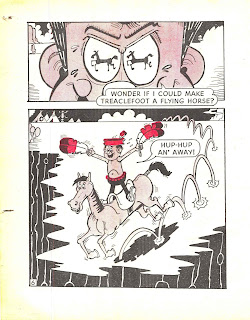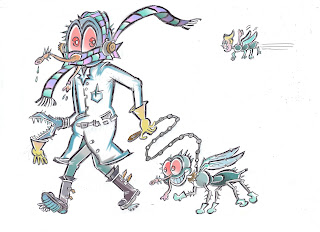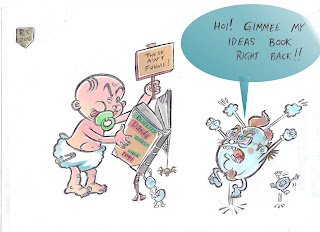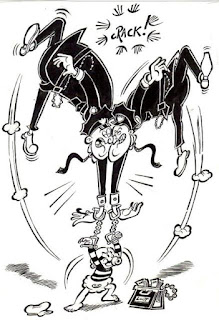Archive-ology
HERE WE DELVE INTO 'PreHistory' as a very early incarnatiion of my cartoon drawings are dredged up from within my dusty archives, and spewed forth upon an unsuspecting world.
At the age of 22-and-a-half, I was delighted to join the staff of BEANO publishers D C Thomson as a freelance cartoonist: a very exciting time it was for me then back in the 80s....although it has to be said there were a lot more openings for artists back then, work opportunities for cartoon-comic artists were much more bountiful compared to the 'graveyard' situation we see today.
In my youth, I was something of an anti-Establishment bohemian, a sort of 'fringe anarchist' who hypocritically still bought Multi-packs of assorted-flavor potato chips..........with my healthy disregard for 'straight' society: there were very few things I truly respected in the Rat Race that makes up the Working World, but comics were one of them....perhaps this route could offer an opportunity for me to find a vocation in life?
The 1980s were not especially great times---creatively-----for British cartoon art: the mid-50s to the early 70s period witnessed much more impressive material in the main. The 80s are typified by two developments I feel helped to 'kill off' [or at least, as good as kill off ] the once thriving 'funnies' comics Industry: these are the scaling down of most professional pages down to A3 from A2------forcing the artist to simplify his or her approach to fit the more cramped frames-------also, there was an unfortunate vogue in that period for 'zippier drawing' that often looked rushed and sketchy: sadly, this approach often became the norm in this decade, and I feel the Industry never really recovered from this drop in standards.
It certainly was not all uniformally bad, but an ambience of corner-cutting was most certainly beginning to creep in. There was an unspoken sense that the true Glory Days were over, and that the Industry was trading on past successes ........this still continues today, of course, with most brand-new BEANO material being updated retreads of established hits, rather than breaking radical new ground, which is obviously a lot more risky. It's healthier, though......
The Industry never paid nearly enough for good artists to put out their best, accomplished work which naturally takes longer to produce; this is one of the reasons many good artists like John Geering or Robert Nixon went the sketchy route, but in the long run this situation made for shoddy comics compared to say the 60s period. The true rot set in during the 80s: you could sense it, even at the time. It was just not a healthy time for comics development.
But back to my own material as seen below here: looking at this now, I think you can still recognize this as being my style, but the undoubted vitality and lack of discipline on my behalf back then makes for uneven reading: I really was trying my best back then, but there is no doubt I can draw much better today. Other new artists from that time peaked quicker and matured faster than I was capable of: I am more of a 'slow burner' who has built up his skill slowly over years of continued drawing---but hey, so did Dudley D Watkins!
Without the work I done for D C T, it is highly unlikely I would be at the level of drawing ability I am putting out today. The work I done there was extremely valuable in learning how to put comic-strip stories together: I entered their offices as an enthusiastic novice, and by the time I finished there, I could draw to a professional level. Working for this company was an experience I would not have missed for the world, the only other job existant anywhere in the World I would have preferred over getting paid for doing cartoons would have been taking photos of ladies for MEN ONLY.
Seriously, though, I credit D C Thomson with being the biggest single factor in inspiring me to take up cartooning, and to offer me work where I was thrown in at the deep end as a complete novice, which accelerated my potential to a high degree.
So, what was it like doing drawings for the famous BEANO publishers?
---it was very informal and open-door---ONCE it was established you were genuinely interested in this field, and not just out to make a fast buck---I impressed the Editors with my fairly decent knowledge on comics-history: no mean feat, back in those pre-internet days.
For example: on my very first visit, I took advantage of selecting a bound volume of 1969 SPARKY sitting up on the shelves in the same office---I yearned to revisit this childhood favorite comic after 15 years. I pointed out the color centerspread of KINGS of the CASTLE, drawn by Ken Harrison [I never knew the artists' name then]-----to DANDY Editor David Torrie , asking him:
------That's who draws the new version of Desperate Dan, isn't it?
-----why, yes: how did you know that?
-------I recognize drawing styles, even when heavily disguised like this.
Only an uber-cartoon enthusiast like me would have spotted a quirk like this, and in the days before the Internet, the World of Comics was as mysterious and as far removed from everyday life as Hollywood was: you had to do all your own research and there was next to nothing to help enthusiasts in the analog days. Enthusiasm like mine got noticed by the Editors and I feel this certainly helped me to get my foot in the door.
It was not easy for an unknown like me to start up a brand-new character, but if you fancied drawing, say, Korky the Cat or Minnie the Minx, you could bring in inked character sheets of these characters and if they were good enough you could end up getting a try-out for them. You could submit stories as well [which was easier money] and in fact I wrote and drew about half of my output there.
Technique-wise, everything was 'organic' with pencil and steel nibs on thick Bristol Board: it was closer to nature than a lot of the impressive-but-sterile computer malerky we see today...the only use of computers back then was for color, the bucket-tool option was in use [I think] for the limited color pallette seen below, and mistakes/censored items were usually fixed by glue-ing on paper patches over the offending region. Lower-tech, perhaps, but the skill of being an artist was paramount and many long-standing, famous artists used all these tricks of the trade.
Word balloons were still stuck on using scalpels and gum---there was a young punk Mohican lass who sat there doing this, I remember.
It was great to see the original inkings of great, famous artists such as Robert Nixon/ John Geering/ David Sutherland, Ken Harrison and many more: the originals were twice as large as the printed size with wide borders, and the finished artwork was pure jet black and crisp white, which is often lost when seen at the printed stage. Artists used to casually walk in with their latest comic-cover: being freelance meant working at home, but as I lived fairly close by in Edinburgh, it was easy for me to pop in regularly. Transport costs were a lot cheaper in the 80s. There were in- house-artists working there, but I do not remember meeting them: artists sometimes visited after traveling up to the offices from England. Without the Internet, most business was done by mail, or handing it in personally. Some artists like Little Plum cartoonist Ron Spencer never visited the offices for decades.
There was a room with a very sexy pool of young female typists.
Anyway---I'm rambling.
This recollection above represents but a mere fraction of what I saw at first hand at the THOMSON offices: later on, I will likely add in more revelations.
COPYRIGHT CHARACTERS D C THOMSON and Co LTD
At the age of 22-and-a-half, I was delighted to join the staff of BEANO publishers D C Thomson as a freelance cartoonist: a very exciting time it was for me then back in the 80s....although it has to be said there were a lot more openings for artists back then, work opportunities for cartoon-comic artists were much more bountiful compared to the 'graveyard' situation we see today.
In my youth, I was something of an anti-Establishment bohemian, a sort of 'fringe anarchist' who hypocritically still bought Multi-packs of assorted-flavor potato chips..........with my healthy disregard for 'straight' society: there were very few things I truly respected in the Rat Race that makes up the Working World, but comics were one of them....perhaps this route could offer an opportunity for me to find a vocation in life?
The 1980s were not especially great times---creatively-----for British cartoon art: the mid-50s to the early 70s period witnessed much more impressive material in the main. The 80s are typified by two developments I feel helped to 'kill off' [or at least, as good as kill off ] the once thriving 'funnies' comics Industry: these are the scaling down of most professional pages down to A3 from A2------forcing the artist to simplify his or her approach to fit the more cramped frames-------also, there was an unfortunate vogue in that period for 'zippier drawing' that often looked rushed and sketchy: sadly, this approach often became the norm in this decade, and I feel the Industry never really recovered from this drop in standards.
It certainly was not all uniformally bad, but an ambience of corner-cutting was most certainly beginning to creep in. There was an unspoken sense that the true Glory Days were over, and that the Industry was trading on past successes ........this still continues today, of course, with most brand-new BEANO material being updated retreads of established hits, rather than breaking radical new ground, which is obviously a lot more risky. It's healthier, though......
The Industry never paid nearly enough for good artists to put out their best, accomplished work which naturally takes longer to produce; this is one of the reasons many good artists like John Geering or Robert Nixon went the sketchy route, but in the long run this situation made for shoddy comics compared to say the 60s period. The true rot set in during the 80s: you could sense it, even at the time. It was just not a healthy time for comics development.
But back to my own material as seen below here: looking at this now, I think you can still recognize this as being my style, but the undoubted vitality and lack of discipline on my behalf back then makes for uneven reading: I really was trying my best back then, but there is no doubt I can draw much better today. Other new artists from that time peaked quicker and matured faster than I was capable of: I am more of a 'slow burner' who has built up his skill slowly over years of continued drawing---but hey, so did Dudley D Watkins!
Without the work I done for D C T, it is highly unlikely I would be at the level of drawing ability I am putting out today. The work I done there was extremely valuable in learning how to put comic-strip stories together: I entered their offices as an enthusiastic novice, and by the time I finished there, I could draw to a professional level. Working for this company was an experience I would not have missed for the world, the only other job existant anywhere in the World I would have preferred over getting paid for doing cartoons would have been taking photos of ladies for MEN ONLY.
Seriously, though, I credit D C Thomson with being the biggest single factor in inspiring me to take up cartooning, and to offer me work where I was thrown in at the deep end as a complete novice, which accelerated my potential to a high degree.
So, what was it like doing drawings for the famous BEANO publishers?
---it was very informal and open-door---ONCE it was established you were genuinely interested in this field, and not just out to make a fast buck---I impressed the Editors with my fairly decent knowledge on comics-history: no mean feat, back in those pre-internet days.
For example: on my very first visit, I took advantage of selecting a bound volume of 1969 SPARKY sitting up on the shelves in the same office---I yearned to revisit this childhood favorite comic after 15 years. I pointed out the color centerspread of KINGS of the CASTLE, drawn by Ken Harrison [I never knew the artists' name then]-----to DANDY Editor David Torrie , asking him:
------That's who draws the new version of Desperate Dan, isn't it?
-----why, yes: how did you know that?
-------I recognize drawing styles, even when heavily disguised like this.
Only an uber-cartoon enthusiast like me would have spotted a quirk like this, and in the days before the Internet, the World of Comics was as mysterious and as far removed from everyday life as Hollywood was: you had to do all your own research and there was next to nothing to help enthusiasts in the analog days. Enthusiasm like mine got noticed by the Editors and I feel this certainly helped me to get my foot in the door.
It was not easy for an unknown like me to start up a brand-new character, but if you fancied drawing, say, Korky the Cat or Minnie the Minx, you could bring in inked character sheets of these characters and if they were good enough you could end up getting a try-out for them. You could submit stories as well [which was easier money] and in fact I wrote and drew about half of my output there.
Technique-wise, everything was 'organic' with pencil and steel nibs on thick Bristol Board: it was closer to nature than a lot of the impressive-but-sterile computer malerky we see today...the only use of computers back then was for color, the bucket-tool option was in use [I think] for the limited color pallette seen below, and mistakes/censored items were usually fixed by glue-ing on paper patches over the offending region. Lower-tech, perhaps, but the skill of being an artist was paramount and many long-standing, famous artists used all these tricks of the trade.
Word balloons were still stuck on using scalpels and gum---there was a young punk Mohican lass who sat there doing this, I remember.
It was great to see the original inkings of great, famous artists such as Robert Nixon/ John Geering/ David Sutherland, Ken Harrison and many more: the originals were twice as large as the printed size with wide borders, and the finished artwork was pure jet black and crisp white, which is often lost when seen at the printed stage. Artists used to casually walk in with their latest comic-cover: being freelance meant working at home, but as I lived fairly close by in Edinburgh, it was easy for me to pop in regularly. Transport costs were a lot cheaper in the 80s. There were in- house-artists working there, but I do not remember meeting them: artists sometimes visited after traveling up to the offices from England. Without the Internet, most business was done by mail, or handing it in personally. Some artists like Little Plum cartoonist Ron Spencer never visited the offices for decades.
There was a room with a very sexy pool of young female typists.
Anyway---I'm rambling.
This recollection above represents but a mere fraction of what I saw at first hand at the THOMSON offices: later on, I will likely add in more revelations.
COPYRIGHT CHARACTERS D C THOMSON and Co LTD


















Comments
Post a Comment